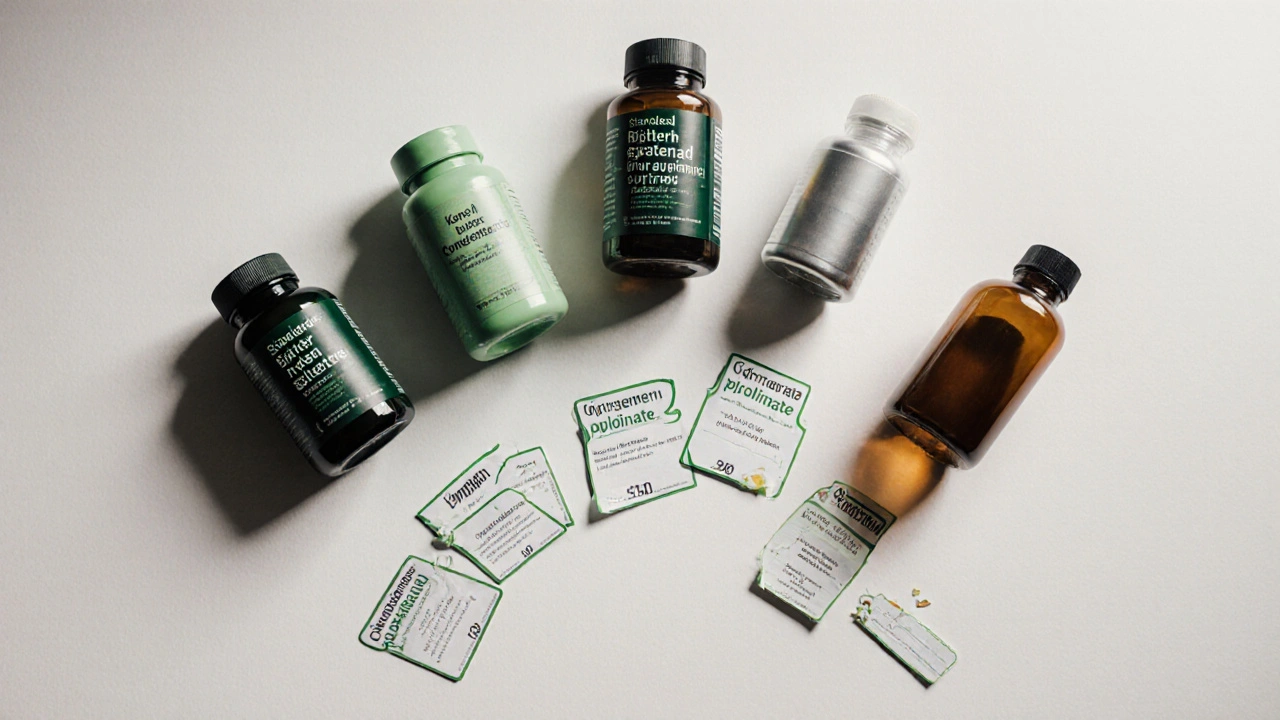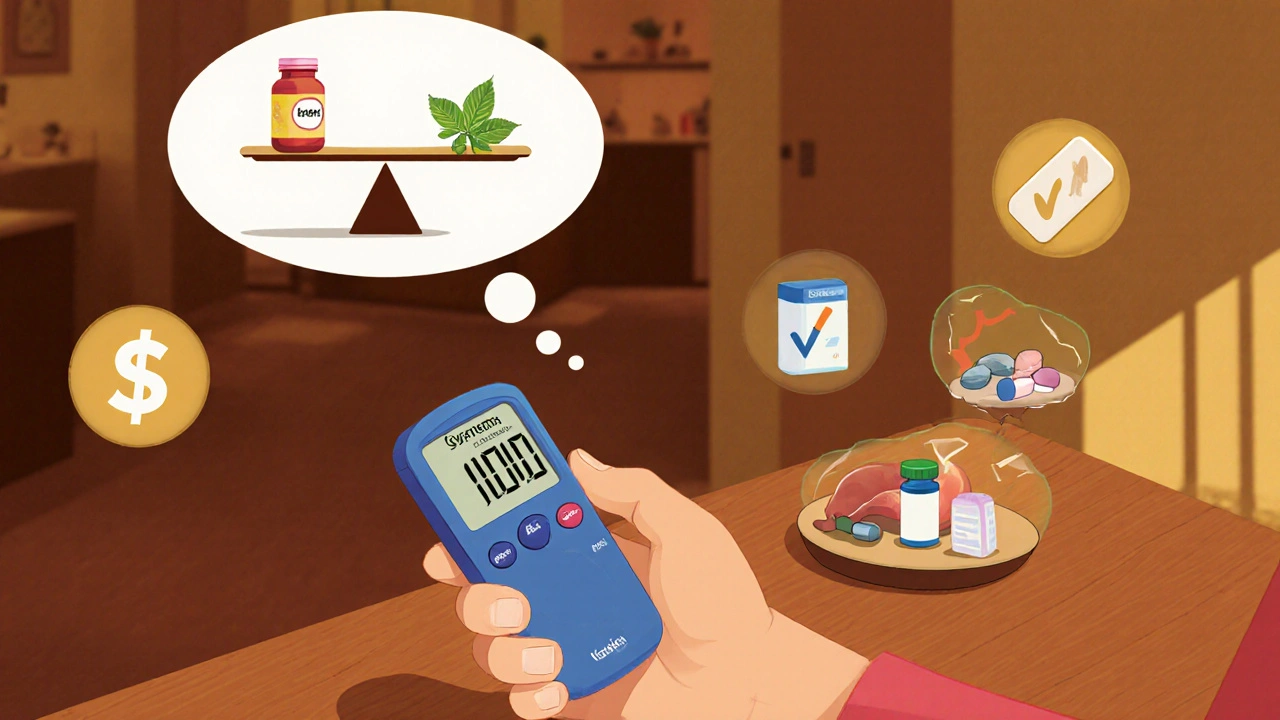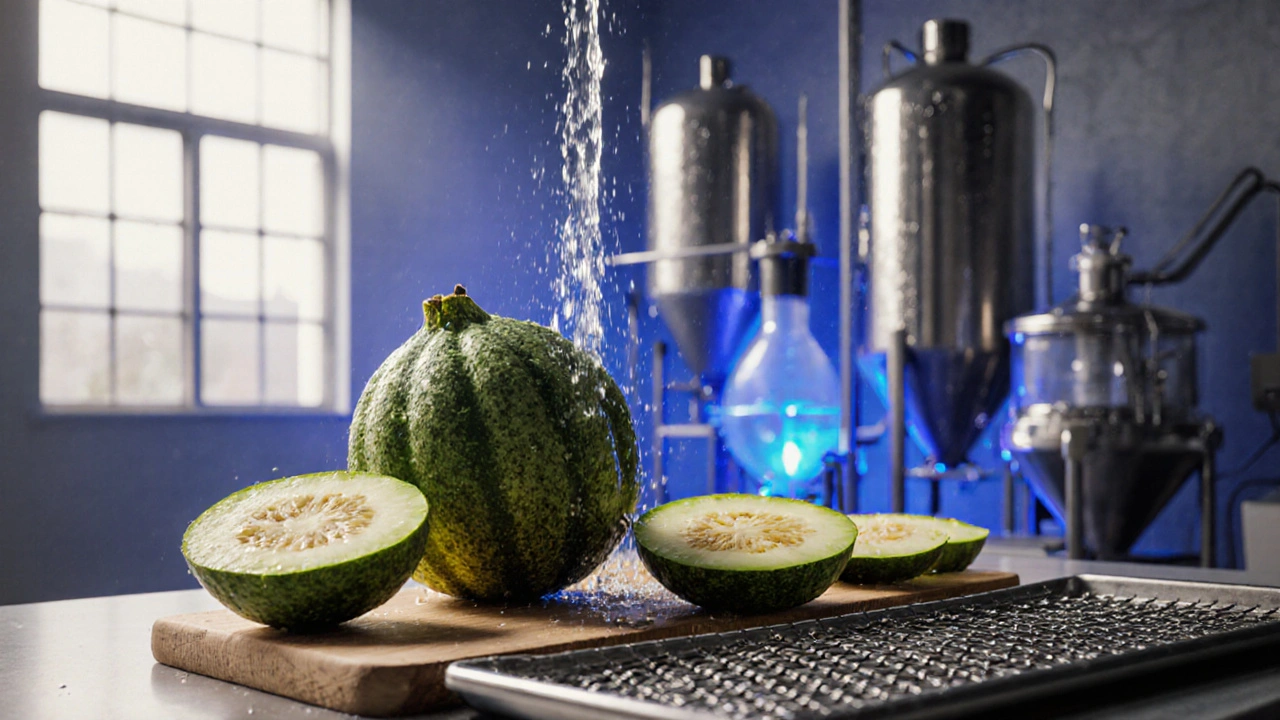Blood Sugar Support Selector
Find Your Best Match
Select your top priorities to discover which supplement aligns best with your needs.
Your Best Match
Karela concentrate is a normalized extract of Momordica charantia (bitter melon) standardized to specific bioactive compounds such as charantin, momordicosides, and cucurbitacins. It is marketed mainly for blood‑glucose support. If you’re trying to decide whether this supplement is worth your money, you’re not alone. Many people compare it with other herbal or nutraceutical options that claim similar benefits. Below is a straightforward, side‑by‑side look that lets you see the pros, cons, and key differences without wading through marketing fluff.
Key Takeaways
- Karela concentrate offers a well‑studied blend of bitter‑melon actives but can be pricey and variable in potency.
- Standardized bitter‑melon extract, Gymnema sylvestre, and chromium picolinate all have solid research bases, each with unique strengths.
- Choosing the right product depends on your blood‑sugar goals, budget, and tolerance for possible side effects.
- Look for third‑party testing and clear dosage instructions to avoid sub‑therapeutic batches.
How Karela Concentrate Is Made
The manufacturing process begins with fresh Momordica charantia fruit, which is washed, sliced, and dried. The dried material is then extracted with ethanol or water, and the extract is concentrated under reduced pressure. Manufacturers add a standardization step to lock in a minimum percentage of charantin (usually 5‑7%) and other markers. This “normalized” label means the product should deliver a consistent amount of active compounds per dose, a claim that not all bitter‑melon supplements can substantiate.
Top Alternatives on the Market
Below are the most common competitors you’ll encounter when searching for blood‑glucose support.
- Standardized Bitter Melon Extract: A less processed version that may contain 2‑4% charantin.
- Gymnema sylvestre (Gymnema leaf)
- Chromium picolinate (mineral supplement)
- Alpha‑lipoic acid (antioxidant)

Comparison Table
| Product | Main Active | Standardization | Typical Daily Dose | Evidence for Blood‑Sugar Lowering | Common Side Effects | Average Price (AU$) per Month |
|---|---|---|---|---|---|---|
| Karela concentrate | Charantin, momordicosides, cucurbitacins | Charantin ≥5%, total momordicosides ≥2% | 500mg (standardized) | Moderate - several RCTs show 10‑15% reduction in fasting glucose | GI discomfort, occasional hypoglycemia | 45‑60 |
| Standardized bitter‑melon extract | Charantin | Charantin 2‑4% | 600mg | Low‑to‑moderate - fewer clinical trials | Mild stomach upset | 30‑40 |
| Gymnema sylvestre | Gymnemic acids | Gymnemic acids ≥25% | 400mg | Strong - multiple studies report 12‑20% glucose drop | Rare nausea, taste loss | 35‑50 |
| Chromium picolinate | Chromium (III) | Purity ≥99% | 200µg | Variable - meta‑analyses show modest 5‑8% effect | Headache, skin reactions | 15‑25 |
| Alpha‑lipoic acid | R‑α‑lipoic acid | ≥99% purity | 600mg | Good - improves insulin sensitivity in several trials | Dizziness, skin tingling | 20‑35 |
When Karela Concentrate Might Be the Better Choice
Choose Karela concentrate if you prefer a plant‑based product that bundles several bioactive compounds in one capsule. Its multi‑component profile (charantin + momordicosides + cucurbitacins) can target glucose production, absorption, and insulin signaling simultaneously. For people who have already tried single‑ingredient options with limited results, the broader spectrum may provide the extra push.
Scenarios Where an Alternative Shines
- Budget‑conscious shoppers: Chromium picolinate delivers modest benefits for a fraction of the cost.
- Those seeking rapid glucose drops: Gymnema sylvestre’s gymnemic acids have the strongest peer‑reviewed data for acute reductions.
- People with digestive sensitivity: Alpha‑lipoic acid is less likely to cause stomach upset compared with bitter‑melon extracts.
- Combined therapy: Some clinicians stack a low‑dose Karela concentrate with chromium to cover both insulin‑sensitivity and glucose‑production pathways.

How to Evaluate Product Quality
Regardless of the brand you pick, apply these three checks:
- Third‑party testing: Look for certificates of analysis (COA) that list exact percentages of the active markers.
- Clear dosage guidance: The label should state how many milligrams of standardized extract equal a therapeutic dose.
- Transparent sourcing: Ethical farming practices and non‑GMO claims reduce the risk of contaminants.
Potential Interactions and Safety Tips
All the products listed can interact with prescription diabetes meds, potentially causing hypoglycemia. Start with a half‑dose, monitor blood glucose closely, and discuss any supplement addition with your healthcare provider. Pregnant or breastfeeding individuals should avoid high‑dose bitter‑melon products due to limited safety data.
Bottom Line
If you value a comprehensive plant profile and are okay with a higher price tag, Karela concentrate stands out as the most complete bitter‑melon option on the market. For tighter budgets, sharper clinical evidence, or a gentler stomach experience, alternatives like Gymnema sylvestre, chromium picolinate, or alpha‑lipoic acid may fit better. Use the comparison table as a quick reference, match the product to your personal priorities, and always verify quality through third‑party testing.
Frequently Asked Questions
What does “normalized” mean on a Karela supplement label?
Normalization indicates the manufacturer has adjusted the extract so each serving contains a guaranteed minimum amount of key actives (e.g., charantin ≥5%). This reduces batch‑to‑batch variability and ensures you get a consistent dose.
Can I take Karela concentrate together with my metformin?
Yes, but only under medical supervision. Both can lower blood glucose, so you’ll need to monitor levels closely to avoid hypoglycemia. A common practice is to start with half the recommended supplement dose and adjust based on your glucose readings.
Is bitter‑melon extract the same as Karela concentrate?
Not exactly. Bitter‑melon extract is a broad term that may refer to any preparation of Momordica charantia. Karela concentrate is a specific, often more highly standardized version that guarantees a set level of charantin and other actives.
Which alternative has the strongest scientific backing?
Gymnema sylvestre currently holds the most robust clinical evidence for acute glucose reduction, followed closely by Alpha‑lipoic acid for improving insulin sensitivity.
How long should I use a Karela supplement before seeing results?
Most users notice modest improvements in fasting glucose after 4‑6 weeks of consistent dosing, but individual response times vary based on diet, medication, and baseline glucose levels.



Tommy Mains
October 12, 2025 AT 02:15Hey folks, great rundown! If you’re new to these supplements, start with a low dose and track your fasting glucose for a couple of weeks. This helps you see if the product actually moves the needle for you. Also, check the label for a COA so you know the extract is standardized. Remember to talk to your doctor before mixing anything with prescription meds.
Alex Feseto
October 18, 2025 AT 04:13Esteemed colleagues, the comparative matrix presented herein exhibits commendable methodological rigor; however, the omission of pharmacokinetic parameters, such as Cmax and half‑life, diminishes its comprehensiveness. Incorporating these metrics would facilitate a more nuanced appraisal of therapeutic suitability.
vedant menghare
October 24, 2025 AT 13:00Namaste, dear readers! In many South‑Asian households, bitter melon (karela) has been cooked for generations to aid digestion and blood‑sugar balance. The modern concentrate you see today is essentially a laboratory‑refined version of that ancestral wisdom. While the standardization adds consistency, it also strips away some of the synergistic fibres found in the whole fruit. Therefore, consider whether you prefer the traditional culinary approach or the convenience of a capsule. Both paths can coexist in a balanced regimen.
Kevin Cahuana
October 30, 2025 AT 21:46Yo, I get why people gravitate toward Gymnema for that quick drop, but Karela’s multi‑compound profile can be a silent powerhouse over time. If your stomach’s a bit sensitive, start with half the dose and see how you feel. Keep an eye on any wobble in your glucose readings, especially if you’re on meds.
Danielle Ryan
November 6, 2025 AT 06:33Listen up!!! They don’t tell you in the ads that these “natural” powders could be part of a grand surveillance scheme!!! Every batch is probably tagged with a micro‑chip, and the big pharma giants are watching how we tweak our blood sugar!!! Stay woke!!!
Robyn Chowdhury
November 12, 2025 AT 15:20In the grand theatre of supplementation, one must consider the tragic heroism of over‑promising brands. The data is solid, yet the narrative often drifts towards melodrama. 🤔 Nevertheless, a measured approach, guided by third‑party testing, remains the most rational script.
Deb Kovach
November 19, 2025 AT 00:06Let’s break down the practical aspects of each option, step by step, so you can make an informed choice without feeling overwhelmed.
First, look at the active ingredient profile: Karela concentrate bundles charantin, momordicosides, and cucurbitacins, offering a multi‑targeted approach to glucose metabolism.
Second, consider the standardization level – the ≥5% charantin guarantee is one of the higher benchmarks in the market.
Third, examine clinical evidence: several randomized controlled trials have shown a 10‑15% reduction in fasting glucose after 6‑8 weeks of consistent dosing.
Fourth, weigh side‑effect tolerability; gastrointestinal discomfort is the most common complaint, but it’s usually mild and can be mitigated by taking the capsule with food.
Fifth, evaluate cost – at AU$45‑60 per month, Karela sits in the mid‑to‑high price tier, which may be a barrier for budget‑conscious users.
Sixth, compare alternatives: Gymnema sylvestre provides the strongest acute glucose‑lowering data, but its price is comparable and it may cause taste alteration for some.
Seventh, chromium picolinate is the cheapest, yet its effect size is modest (5‑8% reduction) and it can cause skin reactions in sensitive individuals.
Eighth, alpha‑lipoic acid excels at improving insulin sensitivity with a favorable side‑effect profile, though it lacks the multi‑compound synergy of bitter melon.
Ninth, standardized bitter‑melon extracts are cheaper than Karela but often have lower charantin content, translating to variable efficacy.
Tenth, always verify third‑party testing – a COA should list exact percentages of the actives and confirm purity.
Eleventh, check dosage clarity – the label should specify how many milligrams of standardized extract constitute a therapeutic dose.
Twelfth, consider sourcing – non‑GMO, ethically farmed fruit reduces the risk of contaminants.
Thirteenth, be aware of potential drug interactions; all these supplements can amplify the effect of prescription diabetes medications, so start low and monitor closely.
Fourteenth, for pregnant or breastfeeding individuals, err on the side of caution and avoid high‑dose bitter‑melon products due to limited safety data.
Finally, match the product to your personal priorities: if you value a comprehensive plant profile and can accommodate a higher price, Karela concentrate is a solid choice; if you need rapid glucose drops or a gentler stomach experience, Gymnema or alpha‑lipoic acid may be better fits. By following this checklist, you can navigate the supplement aisle with confidence and avoid common pitfalls.
Sarah Pearce
November 25, 2025 AT 08:53Looks pricey but might work.
Ajay Kumar
December 1, 2025 AT 17:40Hey everyone, just wanted to add that personal experience matters a lot. I tried Karela concentrate for a month and saw a slight dip in my fasting numbers, but the real win was feeling less post‑meal sugar spikes. If you’re juggling multiple meds, maybe start with half the dose and see how your body reacts. Also, don’t forget lifestyle – diet and exercise still rule the day.
Richa Ajrekar
December 8, 2025 AT 02:26While the post tries to be balanced, it subtly glorifies foreign supplements over locally sourced ones, which feels a bit off‑patriotic. It would be better to see more emphasis on Indian‑grown bitter melon varieties that are equally effective.